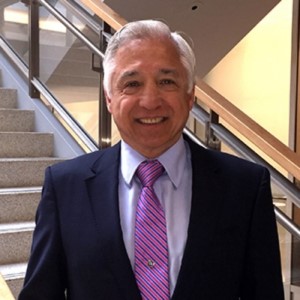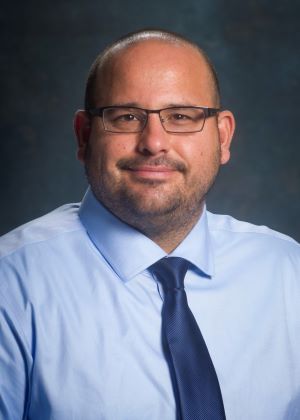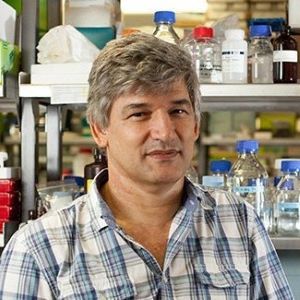-
Garcia-Martinez, J Victor Ph.D.
Garcia-Martinez, J Victor Ph.D.
Dr. Garcia has been engaged in translational biomedical research for over 30 years and is a leader in research on the in vivo analysis of cancer, HIV transmission, prevention and cure. Dr. Garcia has made seminal contributions to our understanding of HIV pathogenesis, specifically the function of Nef, which is an important determinant of disease progression.
More recently, Dr. Garcia’s group has established an outstanding track record in the development, implementation and use of humanized mice. Since their landmark publication describing the humanized BLT mouse model and its derivatives, have been widely used to address key questions of HIV infection, transmission, prevention, and more recently, persistence and cure.
The recent development of the lung-only-mouse and BLT-lung models have dramatically expended the tropism of pathogens that can be studied in vivo using humanized mice. These new models have been used to study key aspects of the biology of respiratory viruses including SARS-CoV-2, MERS, SARS, RSV, and CMV including the evaluation of novel therapeutic approaches for the control of emerging and re-emerging pathogens.
Pathogens being investigated:
- SARS, SARS-CoV-2, MERS, Bat Corona Viruses, Influenza
- African Swine, Fever Virus, Dengue Virus
- Mycobacterium tuberculosis
-
Harrod, Kevin Ph.D.
Harrod, Kevin Ph.D.
Dr. Kevin Harrod’s research focuses on elucidation of underlying mechanisms of respiratory viral infections, pneumonia, sepsis and critical illness, with a particular emphasis on disease caused by influenza virus and SARS-CoV-2, the etiologic agent of COVID-19. Using translational and molecular approaches, Dr. Harrod’s lab is uncovering the underlying causes of secondary bacterial infection and pneumonia following respiratory viral infection.
Furthermore, Dr. Harrod is focused toward discovery of novel antiviral interventions that target both influenza and SARS-CoV-2. The overarching goals of this laboratory is to identify novel interventions, therapies, and treatments to respiratory infections and critical illness.
Pathogens being investigated:
- High and Low Pathogenic Avian Influenza Virus
- SARS-CoV2
-
Lund, Frances Ph.D.
Lund, Frances Ph.D.
Dr. Frances Lund laboratory study the role that innate (dendritic cells, monocytes, microglial cells and neutrophils) and adaptive cells (B and T cells) play in immune responses to pathogens, autoantigens and allergens. Their group’s research focus is understanding how anti-viral B cell immunity is established and maintained in the respiratory tract. In collaboration with long-time partners in the Randall lab, the Lund group has shown that B cells can form B cell follicles in the lungs of influenza infected mice and that these B cells contribute to local immunity.
They have also shown that B cells contribute to the development of highly functional memory virus-specific CD8 T cells and do so by producing antibodies that facilitate late antigen presentation by DCs to T cells. Currently, the Lund lab studies pulmonary immunity to COVID19 infection and vaccination, and their work in the SEBLAB consists of the analysis of antibody and memory B cell responses in preclinical mouse and hamster models of SARS-CoV-2.
Pathogens being investigated:
- SARS-CoV2
-
Leal, Sixto M., M.D., Ph.D.
Leal, Sixto M., M.D., Ph.D.
Dr. Leal has a broad background in microbiology, immunology, and medicine with residency training in clinical pathology and fellowship training in medical microbiology. He is the Director of the UAB Clinical Microbiology Laboratory, Fungal Reference Lab, and UAB’s High Containment Research Facility (SEBLAB) with significant expertise in the diagnosis of infectious diseases, medical mycology, and SARS-CoV-2 biology.
His research interests are 4-fold and include 1. Expert laboratory support for a variety of Infectious Disease (ID) clinical trials, 2. Evaluation of new commercial diagnostic tests seeking FDA approval, 3. Development of novel ID diagnostics, and 4. The mechanistic evaluation of host and microbial factors mediating the outcome of invasive mold infections in otherwise healthy hosts including: COVID-Associated 2° mold infections (CAPA/CAM), fungal keratitis, phaeohyphyomycosis, and dimorphic fungal infections.
As the SEBLAB Director, he is currently leading the implementation of cutting-edge scientific equipment and a scientific research team to support in vitro, ex vivo, and in vivo research on high-containment pathogens.
Pathogens being investigated:
- SARS-CoV2
- BSL-2 and BSL-3 Fungi
-
Niederweis, Michael Ph.D.
Niederweis, Michael Ph.D.
Dr. Michael Niederweis is a renowned TB researcher known for his work on the biology of mycobacterial cell envelopes, particularly in Mycobacterium tuberculosis, the causative agent of tuberculosis. One of the most prominent features of M. tuberculosis is the production of large quantities of unusual lipids. The Niederweis lab showed for the first time that these lipids are organized in an outer membrane that plays a crucial role in the intrinsic drug resistance of M. tuberculosis and in its survival in vivo.
This outer membrane is functionalized by mostly unknown proteins of very low abundance. The research focus of his lab is to identify and characterize novel outer membrane proteins because they provide essential functions with unknown mechanisms (nutrient uptake, secretion of small molecules and proteins) and have new structures. The goal of Niederweis lab is to understand how M. tuberculosis funtionalizes its unusual outer membrane on a molecular level and the role of these transport mechanisms in the biology and pathogenesis of M. tuberculosis.
In pioneering efforts his lab discovered the first outer membrane channel protein in mycobacteria, obtained the first crystal structure of a mycobacterial outer membrane protein and identified several novel outer membrane proteins of M. tuberculosis. The Niederweis lab elucidated the mechanisms of secretion and trafficking of the major toxin of M. tuberculosis (TNT), which plays a key role in pathogenesis. In addition, they have identified transporters involved in siderophore secretion, heme uptake and secretion of small proteins. Most of these proteins are important for virulence of M. tuberculosis.
Pathogens being investigated:
- Mycobacterium tuberculosis
-
Rowe, Steven M., M.D., MSPH
Rowe, Steven M., M.D., MSPH
Dr. Steven Rowe’s research group is working to develop animal models of COVID-19, something he has pioneered for cystic fibrosis. In the project “A Ferret Model of COVID-19 Pathogenesis and Treatment“, Rowe’s research group study pursued the hypothesis that the SARS-CoV-2 infection could cause mucociliary dysfunction through the involvement of ciliated respiratory cells, and this could be modeled in certain animals to show severity.
His work has shown that mucociliary dysfunction is in fact happening in animal models and may contribute to secondary infections observed in COVID-19. His group is also testing mucociliary transport enhancing drugs as anti-SARS-CoV-2 therapies using human bronchial epithelial (HBE) cells fully differentiated at air liquid interphase as a model. In this same model, his group is studying the susceptibility of CF HBE cells to SARS CoV-2 compared to normal cells.
Pathogens being investigated:
- SARS-CoV2
-
Steyn, Adrie Ph.D.
Steyn, Adrie Ph.D.
Dr. Adrie Steyn is a basic scientist with appointments at the University of Alabama at Birmingham and Africa Health Research Institute (AHRI), Durban, South Africa. Dr. Steyn have a broad background in molecular genetics, with specific in-depth training and expertise in Mycobacteria tuberculosis (Mtb) virulence and pathogenesis using different animal models for tuberculosis (TB).
Dr. Adrie Steyn laboratory's primary research interest lies in understanding the mechanisms by which M. tuberculosis persists within the human body for extended periods, often without causing symptoms, and then reactivates leading to active TB disease. Their groups research focus shifted slightly towards applying basic science training to understand the fundamental principles of disease and persistence in human pulmonary TB patients.
Dr. Steyn's research contributes significantly to the global fight against TB by providing valuable insights into this complex disease. His work holds promise for the development of new diagnostic tools, treatments, and prevention strategies.
Pathogens being investigated:
- Mycobacterium tuberculosis
-
Wahl, Angela Ph.D.
Wahl, Angela Ph.D.
Dr. Wahl’s overarching research goal is to improve global health by developing precision animal models that recapitulate key aspects of human biology and can be used to conduct basic and translational research about the human condition in health and disease.
Dr. Wahl’s primary research focus is the creation and implementation of humanized mouse models, immunodeficient mice reconstituted with human hematopoietic cells and/or tissues, to address fundamental aspects of basic human immunology, transplantation, cancer and infection with human pathogens including human immunodeficiency virus (HIV), and respiratory viruses and bacteria.
Pathogens being investigated:
- SARS-CoV-2, Human immunodeficiency virus (HIV)
2018 PUBLICATIONS
-
Ferritin H Deficiency in Myeloid Compartments Dysregulates Host Energy Metabolism and Increases Susceptibility to Mycobacterium tuberculosis Infection
Reddy VP, et al., Front Immunol. 2018 May 3;9:860
-
Distribution of Myeloid Heme Oxygenase-1 Protects against Free Radical-Mediated Immunopathology in Human Tuberculosis.
Chinta KC, et al., Cell Rep. 2018 Nov 13;25(7):1938-1952.e5.
-
NAD+ depletion triggers macrophage necroptosis, a cell death pathway exploited by Mycobacterium tuberculosis
Pajuelo, D et al., Cell Reports 2018 24, 429-440
Media: UAB News,Science Daily.
2019 PUBLICATIONS
-
A protein complex from human milk enhances the activity of antibiotics and drugs against Mycobacterium tuberculosis
Meikle, V et al., Antimicrob Agents Chemother. 2019 63, e01846
-
The tuberculosis necrotizing toxin is an NAD+ and NADP+ glycohydrolase with distinct enzymatic properties
Tak U et al., J. Biol. Chem. 2019 294, 3024-3036
-
Heme and hemoglobin utilization by Mycobacterium tuberculosis
Mitra, A et al., Nat Commun . 2019 Sep 18;10(1):4260
2020 PUBLICATIONS
-
Hydrogen sulfide stimulates Mycobacterium tuberculosis respiration, growth and pathogenesis
Saini V, et al., Nat Commun . 2020 Jan 28;11(1):557
-
NAD hydrolysis by the tuberculosis necrotizing toxin induces lethal oxidative stress in macrophages
Pajuelo, D et al., Cell Microbiol. 2020 Jan;22(1):e13115
-
Comprehensive analysis of iron utilization by Mycobacterium tuberculosis
Zhang L et al., PLoS Pathog. 2020 Feb 18;16(2):e1008337
2021 PUBLICATIONS
-
Toxin secretion and trafficking by Mycobacterium tuberculosis.
-
Pore-forming Esx proteins mediate toxin secretion by Mycobacterium tuberculosis
Tak U et al., Nat Commun. 2021 Jan 15;12(1):394.
Media:Nature Communications highlight, UAB News, Science Daily
-
Water-soluble tocopherol derivatives inhibit SARS-CoV-2 RNA-dependent RNA polymerase
Pacl HT, et al.,
bioRxiv [Preprint]. 2021 Jul 27:2021.07.13.449251.
2022 PUBLICATIONS
-
A single intranasal administration of AdCOVID protects against SARS-CoV-2 infection in the upper and lower respiratory tracts
Schultz MD, et al., Hum Vaccin Immunother. 2022 Nov; 18(6):2127292.
-
An intranasal self-amplifying RNA SARS-CoV-2 vaccine produces durable protective respiratory and systemic immunity and prevents viral transmission
Jennewein MF, et al., bioRxiv. 2022.11.10.515993
-
Mycobacterium tuberculosis DosS binds H2S through its Fe3+ heme iron to regulate the DosR dormancy regulon.
Sevalkar RR, et al., Redox Biol . 2022 Jun:52:102316.
-
A periplasmic cinched protein is required for siderophore secretion and virulence of Mycobacterium tuberculosis
Zhang L, et al., Nat Commun. 2022 Apr 26;13(1):2255
2023 PUBLICATIONS
-
NAD(H) homeostasis underlies host protection mediated by glycolytic myeloid cells in tuberculosis
Pacl HT, et al., Nat Commun. 2023 Sep 6;14(1):5472
-
Mucociliary Transport Augmenting Agents Block SARS-Cov-2 Replication in Human Bronchial Epithelial Cells In Vitro
Campos-Gomez J, et al.. Am J Physiol Lung Cell Mol Physiol. 2023 Feb 21.
-
Interferon-dependent signaling is critical for viral clearance in airway neutrophils.
Margaroli C, et al, JCI Insight. 2023 May 22;8(10):e167042.
-
Circulating SARS-CoV-2+ megakaryocytes are associated with severe viral infection in COVID-19
Fortmann SD et al., Blood Adv. 2023 Aug 8;7(15):4200-4214.
-
Mucociliary transport deficiency and disease progression in Syrian hamsters with SARS-CoV-2 infection
Li Q, et al., JCI Insight. 2023 Jan 10;8(1):e163962.
-
Type I interferon-dependent IFIT3 signaling is critical for viral clearance in airway neutrophils
Margaroli C, et al., Res Sq [Preprint]. 2023 Mar 21:rs.3.rs-1812836.
-
Intricate link between siderophore secretion and drug efflux in Mycobacterium tuberculosis
Meikle, V et al., Antimicrob Agents Chemother . 2023 Oct 18;67(10):e0162922
-
Coronary Stent Abscess in the Setting of Arteriovenous Graft Infection following COVID-19: An Autopsy Case Report
Butler JT, Case Reports in Pathology. 2023 May 3:2023:9998749.
-
Differential activation of programmed cell death in patients with severe SARS-CoV-2 infection
Riegler AN, et al., Cell Death Discovery. 2023 Nov 20;9(1):420.
-
Influenza A-induced cystic fibrosis transmembrane conductance regulator dysfunction increases susceptibility to Streptococcus pneumoniae
Earnhardt EY, et al., JCI Insight. 2023 Jul 24;8(14):e170022.
2024 PUBLICATIONS
-
The C-terminus is essential for the stability of the mycobacterial channel protein MspA
Pavlenok M, et al., Protein Sci. 2024 Mar;33(3):e4912.







